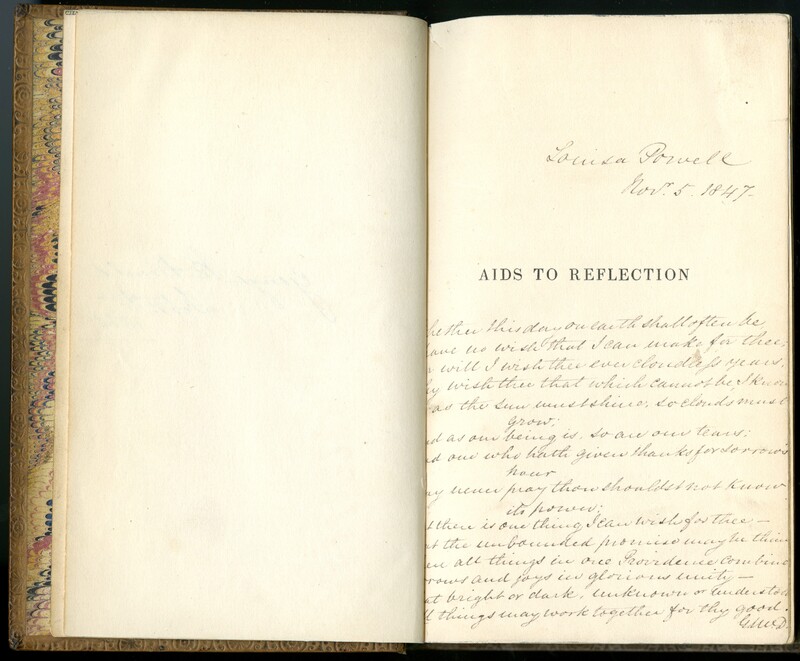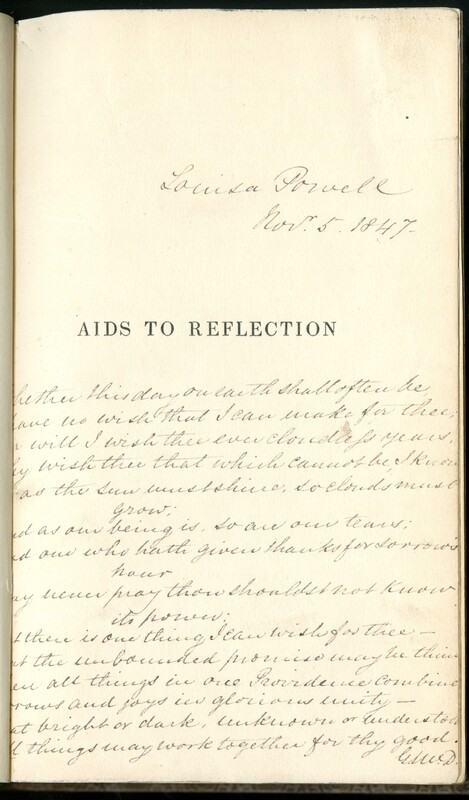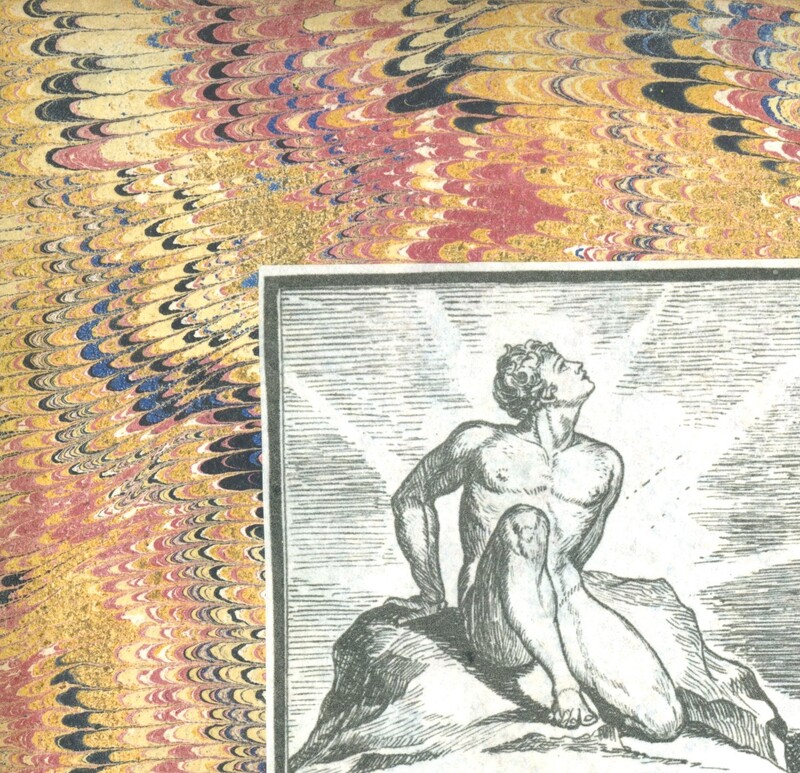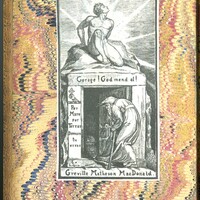George MacDonald's Copy of "Aids to Reflection"
Item
-
Title
-
George MacDonald's Copy of "Aids to Reflection"
-
Description
-
These images come from a copy of Samuel Taylor Coleridge’s "Aids to Reflection" that belonged to Victorian author George MacDonald. One image shows the volume’s title page. This page is yellowed by time and contains a handwritten inscription in black ink in the top right corner to Louisa Powell, along with the date, “Nov. 5. 1847.” Below this inscription and the printed title is a sonnet written in the same script as the name and date. The first few letters of each line of the sonnet are obscured by the crease of the page. Other images show the black-and-white bookplate, bearing the name of “Greville Matheson MacDonald” and set against colourful marbled paper. The illustration on the bookplate depicts two figures, a muscular young man sitting atop a cavernous entryway shrouded in darkness, and another man, stooped with age, carrying a cane, and walking across the threshold of the same entrance. The darkness of the entryway contrasts with light emitting from the young man. The lintel of the cave bears the text “Corage! God mend al!” while the left post bears an image of a hand holding up a cross and the Latin text “per mare per terras domum tu erras” (“through sea and through land, you wander homeward”). At the bottom left-hand corner of the doorway is a Latin epsilon followed by the text “x Libris.” The book is currently held at the Armstrong Browning Library and Museum at Baylor University as part of their George MacDonald collection.
The inscription (as transcribed by Dr. Denae Dyck and Dr. Melinda Creech) reads as follows:
[?Whether] this day on earth shall often be,
[?I h]ave no wish that I can make for thee.
[?Nor] will I wish thee ever cloudless years.
[?Why] wish thee that which cannot be, I know
[?That] as the sun must shine, so clouds must grow.
[?And] as our being is, so are our tears:
[?And] one who hath given thanks for sorrow’s hour
[?May] never pray thou shouldst not know its power;
[?Ye]t there is one thing I can wish for thee –
[?That] the unbounded promise may be thine
[?When] all things in one Providence combine
[?So]rrows and joys in glorious unity –
[?But] bright or dark, unknown or understood,
[?All] things work together for thy good.
-
DENAE DYCK ON WHAT THIS OBJECT TEACHES US:
This copy of "Aids to Reflection" and its inscriptions shed light on George MacDonald’s relationships, influences, and literary work. In addition, they foreground the intimacy of objects, opening up a greater understanding of reading as a material and communal practice.
As Dr. Dyck explains, Louisa Powell (the addressee of both the inscription and the sonnet) was being courted by George MacDonald at the time the inscription was written. The date written on the half title page was Louisa’s 25th birthday; she and MacDonald were married four years later. However, the references to Louisa do not represent the only familial relationship in these pages. Greville Matheson MacDonald, the person named on the book plate, was the eldest son of George and Louisa MacDonald. Dr. Dyck explains that this book plate was very similar to the one that Greville’s father used: both George and Greville used adaptations of William Blake’s “Death’s Door,” an 1813 image that Blake produced for Robert Blaire’s poem “The Grave.” In addition, both of their book plates have the words “Corage! God mend al!” over the doorway, an anagram of “George MacDonald”; Greville added the Latin phrase on the left.
The marks of long-standing and affectionate use found on these pages brought Dr. Dyck to the realization that books are more than just a record of the thoughts of writers and readers. They are also material objects that play active roles in familial contexts. The clear connections to George MacDonald’s family found within the first few pages of this book make clear the communal nature of books and their capacity to move beyond the reader-writer interaction, becoming objects of exchange.
These inscriptions reflect several overarching themes in MacDonald’s published work. As Dr. Dyck points out, MacDonald’s sonnet to Louisa shows his confidence in divine design but also an acknowledgment of life’s unknowns. This twin understanding of fate and mystery is woven through MacDonald’s oeuvre. In a similar way, the image by Blake used as a bookplate brings to mind the influence of Romantic writers on MacDonald (as does the book in its entirety). The bookplate also raises questions about mortality and immortality, questions that represent a throughline in MacDonald’s work, according to Dr. Dyck. This book, then, is intimately connected to the people that owned it. Its materiality is shaped by both their spiritual beliefs and their personal relationships.







